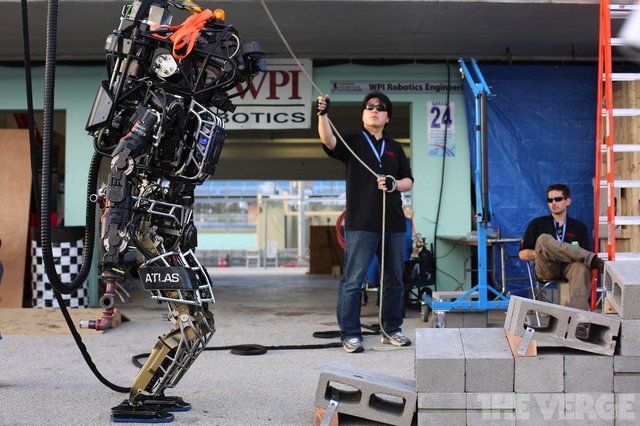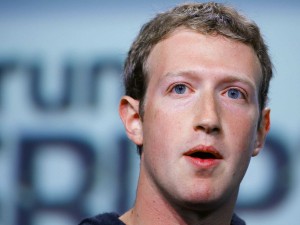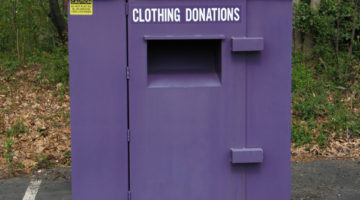 Japan’s prime minister wants to host the first ‘robot Olympics’ in 2020
Japan’s prime minister wants to host the first ‘robot Olympics’ in 2020
By Carl Franzen @carlfranzen
For as long as there have been robots, humans have wanted to thrust them into battle. Now Japan’s prime minister wants to take that idea to the largest stage possible. Speaking to reporters last weekend at a robot factory north of Tokyo, Prime Minister Shinzo Abe was reported by Jiji Press (via the Telegraph) as saying: “In 2020 I would like to gather all of the world’s robots and aim to hold an Olympics where they compete in technical skill.”
Tokyo is already hosting the 2020 Summer Olympics, but presumably the robot competition would be a separate event. Will it be like BattleBots or more like DARPA’s Robotics Challenge, or something else entirely (this may be the only time a Real Steel reference is appropriate in a news article)? So far, Abe’s idea is a mere utterance and remains firmly in the realm of science fiction. But with Switzerland planning to hold the first Olympic games for athletes with robotic prosthetics in 2016 (a so-called “cyborg Olympics”), Abe’s idea may not be that difficult to pull off.
Two Well-Known Hackers Built A $150 Device That Protects Cars From Cyber Attacks
Two security experts who a year ago exposed methods for hacking the Toyota Prius and Ford Escape say they have developed technology that would keep automobiles safe from cyber attacks.
At last summer’s Def Con hacking conference in Las Vegas, the two researchers, Chris Valasek and Charlie Miller, described ways to launch dangerous attacks, including manipulating the brakes of the moving Prius and the Ford Escape.
Valasek told Reuters on Tuesday that he and Miller will show off a prototype vehicle “intrusion prevention device” at next month’s Black Hat hacking conference in Las Vegas.
They built the device with about $150 in electronics parts, though the real “secret sauce” is a set of computer algorithms that listen to traffic in a car’s network to understand how things are supposed to work. When an attack occurs, the device identifies traffic anomalies and blocks rogue activity, Valasek said.
The two well-known computer experts decided to pursue the project because they wanted to help automakers identify ways to defend against security vulnerabilities in their products.
“I really don’t care if you hack my browser and steal my credit card,” Valasek said. “But crashing a car is life or death. It is dramatic. We wanted to be part of the solution.”
The research the two have released on the Ford and Toyota cars, as well as work by other experts on different types of vehicles, has raised concerns that somebody might one day try to replicate their work to launch a real-life attack.
Yet the U.S. National Highway Traffic Safety Administration said in a statement on Tuesday that it is not aware of any incidents of consumer vehicle control systems having been hacked.
The auto industry has beefed up efforts to identify and mitigate potential cybersecurity risks over the past few years.
“Cyber security is a global concern and it is a growing threat for all industries, including the automotive,” said Jack Pokrzywa, manager of global ground vehicle standards with SAE International, a group that represents industry engineers.
Pokrzywa declined to comment on the specifics of the new technology from Valasek and Miller, though he said “Any viable solution reducing cyber threats is a step in the right direction.”
A representative for Ford said she had no immediate comment on the device. Officials with Toyota could not be reached for comment.
Comcast admits service rep did what he was trained to do
by Chris Matyszczyk
@ChrisMatyszczyk
When you don’t have a leg to stand on, it’s best to sit down and take stock.
This is what appears to have happened at Comcast after a customer service call, in which a retention agent made a customer want to retain a hammer and bang it very hard, went viral.
Last week, tech journalist Ryan Block posted part of a conversation he had with a Comcast customer service representative. Block simply wanted to disconnect his service, but the rep tried everything, and I truly do mean everything, to persuade him into staying.
While Comcast initially apologized for its rep’s behavior, an internal memo — first obtained by the Consumerist — reveals the company at least understands why it was criticized. A Comcast spokesperson confirmed to CNET that the memo is indeed genuine.
In the memo, Chief Operating Officer Dave Watson admitted: “The agent on this call did a lot of what we trained him and paid him — and thousands of other Retention agents — to do. He tried to save a customer, and that’s important, but the act of saving a customer must always be handled with the utmost respect.”
Watson said it was “painful to listen to the call,” and he added that respecting “customers is fundamental, and we fell short in this instance.”
Continuing a tone of mea culpa, Watson said: “This situation has caused us to reexamine how we do some things to make sure that each and every one of us — from leadership to the front line — understands the balance between selling and listening. And that a great sales organization always listens to the customer, first and foremost.”
Watson makes all the correct noises: “We will review our training programs, we will refresh our manager on coaching for quality, and we will take a look at our incentives to ensure we are rewarding employees for the right behaviors.”
Yet how many calls like this weren’t recorded by Comcast customers? Comcast, the largest cable operating in the US, has around 20 million customers. When a company has what seems like a near-monopoly on cable service, isn’t it an idea to offer a little more charm and a little less annoying hubris?
Will anything change? Perhaps it’ll show in the retention numbers.
You can read Watson’s full memo below:
You probably know that there has been a fair amount of media attention about a recording of a phone call between one of our Customer Account Executives (CAEs) and a Comcast customer. The call went viral on social media and generated news headlines. We have apologized to the customer privately, and publicly on Comcast Voices, making it clear that we are embarrassed by the tone of the call and the lack of sensitivity to the customer’s desire to discontinue service.
I’d like to give you my thoughts on the situation.
First, let me say that while I regret that this incident occurred, the experience that this customer had is not representative of the good work that our employees are doing. We have tens of thousands of incredibly talented and passionate people interacting with our customers every day, who are respectful, courteous and resourceful.
That said, it was painful to listen to this call, and I am not surprised that we have been criticized for it. Respecting our customers is fundamental, and we fell short in this instance. I know these Retention calls are tough, and I have tremendous admiration for our Retention professionals, who make it easy for customers to choose to stay with Comcast. We have a Retention queue because we believe in our products, and because we offer a great value when customers have the right facts to choose the package that works best for them. If a customer is not fully aware of what the product offers, we ask the Retention agent to educate the customer and work with them to find the right solution.
The agent on this call did a lot of what we trained him and paid him – and thousands of other Retention agents – to do. He tried to save a customer, and that’s important, but the act of saving a customer must always be handled with the utmost respect. This situation has caused us to reexamine how we do some things to make sure that each and every one of us – from leadership to the front line – understands the balance between selling and listening. And that a great sales organization always listens to the customer, first and foremost.
When the company has moments like these, we use them as an opportunity to get better, and that’s what we’re going to do. We will review our training programs, we will refresh our managers on coaching for quality, and we will take a look at our incentives to ensure we are rewarding employees for the right behaviors. We can, and will, do better.
Google and IEEE Offer $1 Million Prize for Smaller Power Inverter
NBC NEWS
Bigger isn’t necessarily better, especially when it comes to power inverters, which are devices that convert electricity from direct current (such as solar panels and batteries) into alternating current for use in homes, businesses and electric cars. That’s why Google and the Institute of Electrical and Electronics Engineers are teaming up to offer a $1 million prize to whoever can build a much smaller one. The problem is household inverters are too big – roughly the size of a picnic cooler. Making them smaller would enable more solar-powered homes as they could go to a solar inverter supplier and find an inverter that would fit into their system perfectly. “It will also allow for more efficient distributed electrical grids and could help bring electricity to the most remote parts of the planet,” Google says. Many businesses look to harness the power of the sun themselves by using commercial solar panels – this shows that they are a forward-thinking company that embraces new technologies and renewable energy sources and demonstrates care for the environment and the world at large.
The goal of Google and the IEEE’s ” Little Box Challenge” contest is to reduce the size of power inverters by 10 times or greater – to about the size of a laptop. Whoever accomplishes that engineering feat “will help change the future of electricity,” Google says. And be a million bucks richer.

MacBook Air update solves issues with sleep and blasting fans
John Brownlee
If you have a MacBook Air from mid-2011, you may have noticed intermittent issues where your laptop has a harder time waking up from sleep mode than it normally would have done, and when it does, the fans might loudly blast as if the whole laptop were on fire.
Although rare, these issues have been afflicting customers for at least the last couple of years. But it seems like Apple has finally figured out what’s wrong, as a new update today specifically for mid-2011 MacBook Air owners fixes the longstanding issues.
On Monday, Apple released the MacBook Air EFI Firmware Update 2.9 for Mid 2011 MacBook Air. Here’s the patch notes:
This update is recommended for MacBook Air (Mid 2011) models. This update addresses an issue where systems may take longer to wake from sleep than expected and fixes a rare issue that may cause fans to run at full speed after waking from sleep.
The update weighs in at a svelte 4.3 megabytes, and can be downloaded directly from Apple’s website, or through Software Update or the Mac App Store.
Verizon’s wireless growth is now being driven by tablets
Devindra Hardawar
Verizon may not be adding as many smartphones to its network as it used to, but at least it has new tablet connections thriving on its LTE network.
The company added 1.15 million contracted LTE tablet connections during the second quarter, compared to just 304,000 new smartphone connections, according to its earnings report released today.
Those figures are especially surprising since Verizon also launched Samsung’s Galaxy S5 and HTC’s new One on its network this month, flagship Android phones that could attract new customers. Despite the lack of smartphone growth, Verizon still managed to grow its wireless revenue to $21.5 billion in Q2, a 7.5-percent jump from last year.
It’s getting easier for wireless customers to add tablets to their cellular plans these days – LTE-equipped tablets are cheaper than they used to be, and Verizon is now offering monthly plans that make it easier to add new devices.
A new tablet connection for an existing customer, which typically costs around $10 a month, definitely isn’t worth as much to Verizon as an entirely new wireless customer. But as it gets harder to entice new smartphone consumers, don’t be surprised if carriers start pushing new ways to get other devices from customers online.
Overall, Verizon reported $31.5 billion in revenues in Q2, a 5.7 percent increase from last year and its highest quarterly revenue figure in the past six quarters.

Facebook Crushes Earnings And The Stock Soars To An All-Time High
JIM EDWARDS
Facebook reported its Q2 2014 earnings, blowing away expectations on the top and bottom lines. Revenue went up 61% to nearly $3 billion and earnings per share were $0.42 – 12 cents more than analysts predicted.
Facebook’s gross margins increased dramatically. In essence, the company makes way more in sales this year than it used to, but its cost-base for generating those sales increased only modestly. Income from operations was a staggering $1.4 billion – this time last year it was just $562 million.
The stock went up and flirted with $74, a rise of 4%, after the market closed, hitting an all time high.
People underestimate how huge Facebook is. Even at this late stage of the game, it added 41 million new members last quarter. There are no other apps out there that are accomplishing anything even close to that.
Here are the highlights:
Revenues: $2.91 billion (analysts were expecting $2.81 billion). That’s a nice beat.
EPS non-GAAP: $0.42 (analysts were expecting $0.32) that’s also a good beat.
Monthly active users (MAUs): 1.32 billion, up 14%.
Mobile MAUs: 1.07 billion, up 31%.
Mobile revenue was 62% of ad revenue.
New Windows 9 Screenshots Show The Start Menu
Roland Hutchinson
Microsoft has been making a number of changed to Windows 8, the company is also working on the next version of their OS, and now we have some Windows 9 screenshots.
The two Windows 9 screenshots were revealed by the guys over at MYCE, they are from a build of Windows 9 which was compiled on the 13th of July with build number 9795, and they show the return of a Start Menu in Windows 9.
Changing the lives of people with Alzheimer’s, one iPod and one playlist at a time
BEN LOVEJOY
@benlovejoy
Alive Inside, a documentary film being shown in selected theaters across the U.S., tells the story of a social worker using iPods and personalized playlists to bring new life to nursing home residents with Alzheimer’s.
Dan Cohen puts together playlists of music from when the patients were young, transfers them to an iPod and then plays them to patients who had been unresponsive to conversation, generating dramatic transformations, reports Re/code.
Audiences first encounter Henry hunched over in his wheelchair, head down, hands clasped firmly together, unresponsive to the world around him.
As soon as a pair of headphones are placed on his head, the 94-year-old dementia patient opens his eyes, sits up straight and begins swaying and humming along with the music. Henry speaks animatedly about his favorite band leader, Cab Calloway, and even begins to emulate the jazz artist’s style of scat singing – at one point launching into a rendition of “I’ll Be Home for Christmas.”
Cohen discovered that music tapped into parts of the brain that could not be reached in other ways, and could revitalize people even in late-stage dementia, “demonstrating music’s ability to combat memory loss and restore a deep sense of self to those suffering from it.”
Described as “a joyous cinematic exploration of music’s capacity to reawaken our souls and uncover the deepest parts of our humanity,” Alive Inside won the Audience Award at the 2014 Sundance Film Festival. Apple is reportedly helping to promote the film, and a list of theaters where the film can be seen is available here.
Wireless monitor ‘relieves pressure’ on nursing staff
By Adam Brimelow
Health Correspondent, BBC News
The NHS is starting to test a sticking-plaster-sized patient-monitoring patch.
Placed on the chest, it wirelessly transmits data on heart rate, breathing and body-temperature while the patient is free to move around.
Independent experts say the system, developed in Britain, could ease pressure on wards and has the potential to monitor patients in their own home.
But the Royal College of Nursing says there is no substitute for having enough staff.
Routine checks for vital signs – including temperature, blood pressure and heart rate – are a key part of care and safety in hospitals.
Typically they may be carried out every four hours, depending on the patient’s condition.
But patients can deteriorate between checks, putting them at risk.
It gives us a bit more time with some patients when we know some patients do need that bit more time. ”
Victoria Howard
Nurse
A hospital in Brighton run by the private healthcare firm Spire has been testing the battery-powered patch, which updates information on some of the vital signs every couple of minutes.
The wireless device, developed by the Oxford-based firm Sensium Healthcare, then issues an alert if the readings fall outside pre-set levels, indicating a potential problem.
The patch is placed on the chest just above the heart when the patient is admitted. There are no cables to any monitors. Instead, readings are recorded and transmitted to a box in each room that works like a wi-fi router, passing on data to the hospital IT system.
‘Eases pressures’
Nurse taking blood pressure
It does not replace the routine checks, but staff say it does ease some of the pressures.
Victoria Howard, a staff nurse at the hospital said the system was working well.
“It gives us a bit more time with some patients when we know some patients do need that bit more time,” she said.
“Without this monitor, you’re constantly thinking what’s happening in the next room, and I should go in there and check them.
“Knowing this is on and it works well, we’re able to spend that bit more time.”
Most of the patients at this hospital are in for routine surgery. Some are being treated for cancer.
The matron, Lynette Awdrey, said the patches helped staff focus their efforts on the patients who needed the most support.
“It prioritises you,” she said.
“Nothing will ever replace compete with clinical observation and the assessment of the patients. What this does is alert you sooner, so you can fulfil those observations and assessments of the patient and activate the appropriate care and treatment for them.”
So far, she said, the patches had provided early detection of deterioration in about 12% of patients who had worn them. That is in line with findings from a small trial with the patches at a hospital in Los Angeles.
Safety implications
This could have important safety implications. A study in the British Medical Journal in 2012 concluded that nearly 12,000 deaths in hospitals in England had been preventable. It said clinical monitoring had been a problem in nearly a third of these deaths.
Another advantage of the device is that patients can move around freely. This reduces the risk of complications such as infections, helping patients to recover more quickly, so they can go home sooner, saving on the costs of healthcare.
David Hardman, 71, is happy to wear the patch.
“It gives me reassurance that there’s something, or some equipment looking at it all the time,” he said.
“And I think when the nurse is with you her mind is perhaps a bit more with you rather than thinking about what’s going on in the other rooms.”
Each patch costs £35 and lasts for five days – long enough for most hospital stays.
Wear at home
Independent experts say we are witnessing the start of a revolution in wearable technology, with great potential benefits in healthcare.
Prof Timothy Coats, a consultant in emergency medicine at Leicester Royal Infirmary, said the patch could be useful in a variety of different settings.
“This certainly could have a use in the emergency department from the emergency care phase right through to the first couple of days in hospital when the patient is more liable to deteriorate.
“It also has potentially an application for looking after patients in their own home, because we could observe them remotely rather than in hospital.”
However he points out there are limitations with the current model, which measures heart rate, breathing and body temperature. It is being developed to provide more information, on blood pressure and oxygen levels.
The company says the patch is about to be tested at one NHS trust and 20 more are in talks.
The Royal College of Nursing’s chief executive, Dr Peter Carter, said new technology could be very helpful in alerting nurses and doctors to a patient who was starting to deteriorate – but he also expressed a note of caution.
“Anything which helps that process has to be a good thing,” he said.
“However, we also know that there is no substitute for having enough staff with the right level of skill on every ward, able to give each and every patient the care and attention that critically ill people need.”




